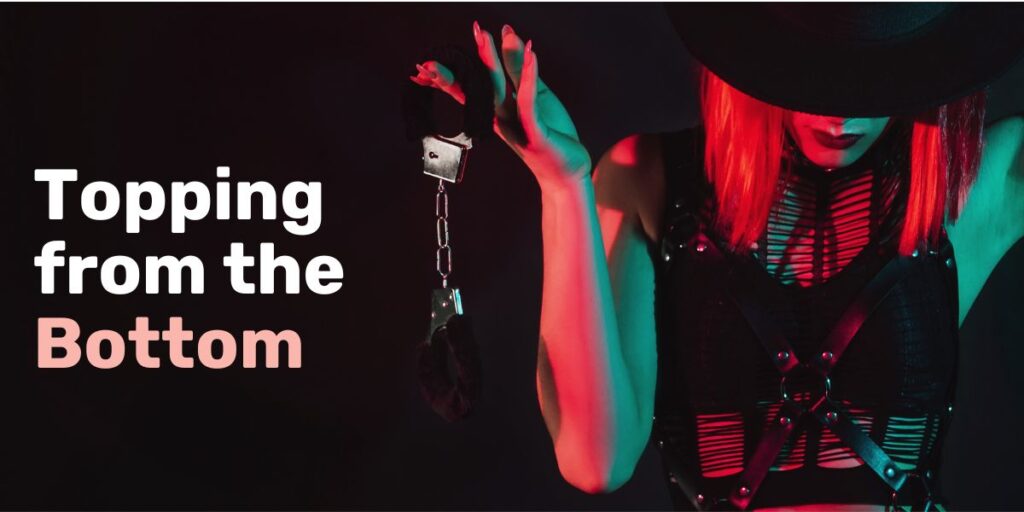
When I first heard the phrase “topping from the bottom,” it confused me. How could someone who identifies as a submissive take control? Isn’t that contradictory? But like many concepts in BDSM, it’s nuanced. And once I understood it, everything made a lot more sense.
Let’s dive into this fascinating dynamic together.
WAIT !
Table of Contents
What is "Topping from the Bottom"?
In simple terms, topping from the bottom occurs when a submissive starts to control the direction of a scene or relationship, often unintentionally. Instead of fully surrendering to the dominant, the submissive might guide, suggest, or subtly manipulate the situation.
For example, imagine being tied up during a rope play scene but continually asking your dominant to adjust the knots, tighten a rope here, or untie one there. While these may seem like harmless suggestions, they can undermine the power exchange dynamic where the dominant is supposed to lead the scene.

How Does It Happen?
Topping from the bottom can be tricky to spot. It’s not always obvious like demanding control outright. Often, it’s much subtler.
Here’s a real-life example: I was in a scene where my partner was blindfolded and tied to a chair. As the dominant, I was guiding the scene, controlling the pace and the intensity.
However, my partner began to “suggest” what I should do next: “Tighter there, please.” “Maybe use the paddle now?” Before I knew it, I was reacting to her instructions instead of guiding the experience.
While some dominants are open to feedback (and in certain situations, it can be constructive), this kind of behavior can unintentionally shift control, turning the dynamic into one where the submissive is in charge—whether that’s desired or not.
Is Topping from the Bottom a Bad Thing?
Topping from the bottom gets a bit of a bad rap, but it’s not inherently bad. It depends on the context. In some relationships, it’s understood and even welcomed. In others, it can disrupt the power balance and lead to frustration on both sides.
For instance, if a dominant is new to the role and uncertain, a more experienced submissive might offer gentle guidance. But if this becomes too frequent, it can cause the dominant to feel undermined or incapable, which can take the excitement out of the dynamic.
When It Becomes a Problem
The main issue with topping from the bottom is that it can blur the lines of power exchange. A submissive who constantly directs the scene can leave the dominant feeling like they aren’t truly in control, which can frustrate both parties.
For example, I once experienced a scene where I’d planned a slow, sensory-driven experience. But my partner, though submissive, kept pushing for a more intense, fast-paced scene.
Their suggestions—while coming from a place of excitement—disrupted the rhythm I was trying to build. The end result? Neither of us felt fully satisfied.
Why Do Some Submissives Top from the Bottom?
This can happen for several reasons, and it’s often not intentional. Sometimes, it’s a lack of trust in the dominant’s abilities.
Other times, it might stem from a fear of letting go completely, especially for people who struggle with vulnerability. They might feel the need to control the situation to avoid discomfort.
Take one of my experiences, for example. A partner of mine had difficulty relaxing into submission because they felt I wasn’t reading them correctly during the scene. Instead of communicating this before or after, they attempted to steer the scene as it was happening.
This disrupted the flow and prevented them from getting the release they were looking for.
How to Navigate or Prevent Topping from the Bottom
The good news? You can navigate this dynamic with communication and clear boundaries.
- For Dominants: Establish your role early on in the scene and make it clear what level of feedback is acceptable. If you’re okay with some guidance, say so upfront. But if it’s taking away from your control, don’t hesitate to address it.
- For Submissives: If you find yourself wanting to control the scene, take a step back. Ask yourself if it’s because you don’t trust your dominant or if you’re having difficulty letting go. Try discussing your concerns outside of the scene, so your dominant knows how to adjust to your needs without you stepping into their role.
For instance, in one of my relationships, we implemented a simple strategy. If my partner felt the need to give feedback during a scene, we used a “traffic light” system. Green meant all was good, yellow meant something was off but didn’t need immediate action, and red meant a hard stop. This allowed my partner to communicate needs without feeling like they were controlling the scene.
When Topping from the Bottom Can Be Beneficial
Surprisingly, topping from the bottom isn’t always negative. There are times when it can enhance a dynamic, especially in longer-term relationships. Some dominants actually enjoy when their submissive guides them on new things they want to explore. It can open the door to fresh ideas and strengthen trust.
For example, I had a partner who loved testing limits, but they didn’t always feel comfortable asking for certain types of play directly. By subtly guiding scenes, they felt more in control of their own boundaries without undermining my role as the dominant.
The Role of Communication and Negotiation
As with anything in BDSM, communication is the key to navigating this dynamic. Discuss roles and expectations before a scene begins, especially if you’ve noticed instances of topping from the bottom in the past.
Negotiation doesn’t have to be long or formal, but it should cover the basics: what each party wants from the scene, any limits, and how feedback will be handled during the play.
Conclusion
Topping from the bottom is a complex, sometimes misunderstood dynamic. It’s not inherently wrong, but when it starts to affect the trust and control between partners, it’s important to address it.
With open communication, clear boundaries, and mutual understanding, it can even become an avenue for deeper connection and exploration.
At the end of the day, every BDSM relationship is unique, and the best way to navigate any dynamic is through trust and transparency.
And don’t forget to check out our Best BDSM Toy Picks..

